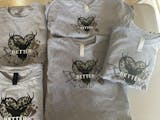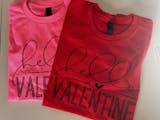Want to create vibrant, detailed designs on almost any fabric? DTF (Direct to Film) transfers might be exactly what you're looking for! With DTF, you can print intricate designs in full color, and apply them to various materials with a simple heat press. If you're intrigued, I've got you covered with a wealth of information below. I'll explain the whole process, from design to application, and offer essential tips to help you achieve the best results with DTF. So keep reading, and let's dive into the details to make sure you're fully prepared to start your DTF journey!
DTF Transfers: The Ultimate Guide to Direct to Film Printing

Direct to Film (DTF) transfers have emerged as a popular and versatile printing method, revolutionizing how designs are applied to various materials. With the ability to produce full-color, detailed graphics on a wide range of products, DTF printing is quickly becoming the go-to choice for both small businesses and large-scale operations. This article will cover everything you need to know about DTF transfers, from the foundational concepts to advanced techniques, ensuring you have a complete understanding of this cutting-edge technology.
What are DTF Transfers?
DTF transfers are a printing technique where a design is printed onto a specialized film, which is then transferred to fabrics and other surfaces through the use of heat and pressure. Unlike traditional methods, DTF allows for intricate designs and vibrant colors, making it ideal for complex graphics and detailed patterns. A DTF printer is used to create these transfers, ensuring precision and high-quality results.
How Does DTF Printing Work?
The DTF printing process involves several key steps:
-
Design Creation: A digital design is created using graphic software.
-
Printing: The design is printed in reverse onto a special PET (polyurethane terephthalate) film using water-based CMYK and white pigment inks. The white layer is printed last to serve as a backing, enhancing the vibrancy of colors on the substrate.
-
Powdering: A hot-melt adhesive powder is applied to the wet ink. This powder adheres to the ink and will bond the design to the fabric.
-
Curing: The film with the adhesive powder is heated to activate the adhesive, creating a solid, transferable layer. This can be done using a heat press, curing oven, or conveyor dryer.
-
Transferring: The film is placed onto the fabric with the printed side down and pressed using a heat press.
-
Peeling: Once the transfer process is complete, the film is peeled away, leaving the design adhered to the fabric. Cold peel film is highly recommended as it will deliver the most vibrant colors and works best when transferring small and fine details.
Benefits of DTF Transfers
DTF transfers offer numerous advantages over other printing methods:
-
Versatility: DTF is compatible with a wide array of materials, including cotton, polyester, blends, ceramics, and even leather.
-
Durability: The transferred designs exhibit excellent wash-fastness and maintain their quality over time.
-
Color Accuracy: DTF transfers offer exceptional color vibrancy and accuracy, ensuring the final product matches the original design.
-
Detailed Designs: This method excels in reproducing intricate designs and fine details, making it suitable for complex graphics.
-
No Weeding or Masking: DTF eliminates the need for weeding or masking, reducing production time and effort.
-
Customization: DTF accommodates various levels of customization, from personalized items to bulk orders.
-
Screen Print-Like Quality: DTF transfers provide a high-quality, screen-print-like finish.
-
Soft Feel: DTF prints are super thin and flex easily with any fabric, ensuring a comfortable feel.
What Can DTF Transfers be Used For?

The versatility of DTF transfers makes them suitable for a wide range of applications:
-
Apparel, including t-shirts, hoodies, and other garments.
-
Accessories, such as hats and bags.
-
Customizable products for businesses and personal use.
-
Textiles and home décor items.
-
Personalized and limited edition products.
How to Apply DTF Transfers
Applying DTF transfers is a straightforward process:
-
Preparation: Make sure the fabric or surface is clean, flat, and wrinkle-free.
-
Positioning: Place the DTF film printed side down onto the fabric.
-
Heat Press Application: Cover the film and fabric with a protective sheet. Apply heat and pressure using a heat press.
-
Cooling: Allow the film to cool completely before peeling.
-
Peeling: Carefully peel off the film to reveal the brilliantly printed design.
-
It’s important to note that no weeding or masking is required. A heat press machine is essential for this application. A home iron is not recommended especially when using DTF transfers for business purposes.
Recommended Heat Press Settings
The following are general guidelines for heat press settings:
-
Time: 7-20 seconds
-
Temperature: 300-320°F (149-160°C) (100% polyester should be used with a lower temperature like 265-285°F
-
Pressure: Medium to heavy
-
It's important to refer to specific product instructions, as variations may occur based on the material.
Washing and Care Instructions
-
Wash garments inside out with cold water.
-
Use a mild detergent.
-
Avoid bleach, fabric softener, and dry cleaning.
-
Dry on low heat or hang to dry to preserve the print.
-
DTF transfers maintain their quality even after multiple washes and dries if proper care is taken.
Artwork Requirements for DTF Transfers
To achieve the best results with DTF transfers, it’s crucial to adhere to specific image requirements:
-
File Format: Use a PNG file with a transparent background for optimal results. Vector artwork such as AI, PDF, EPS, or SVG files are also acceptable.
-
Resolution: A 300 DPI resolution is recommended for the best print quality.
-
Color Mode: Save artwork in RGB color mode, not CMYK.
-
Sizing: Provide the artwork at the exact size it should be printed, as resizing may not be done by the printer. Be sure to remove all transparent pixels around the perimeter of your design. This will likely cause your transfers to be the wrong size when you receive them.
-
Mirroring: Do not mirror your images, as the printer software will handle this automatically.
-
Background: Make sure to remove any unwanted backgrounds or colors from your artwork before uploading.
-
If you have low-quality artwork, we do offer vector redraw services.
What is a DTF Gang Sheet?
A DTF gang sheet is a transfer sheet that contains multiple designs. These sheets come in various sizes, allowing for cost-effective printing of multiple graphics at once. Designs on a gang sheet can be cut out and pressed separately onto different garments or items.
Copyright Restrictions
It's crucial to note that copyrighted content cannot be printed without written permission. Even if the intention is for personal or non-profit use, printing copyrighted artwork is prohibited. We require written permission to print such content.
Choosing the Right Size of DTF Transfer
When selecting a transfer size, it's necessary that the transfer matches the size of your design or is larger for optimal results. Ensure you measure the width and height of your design accurately. If you are using raster artwork, be sure the art is sized to the same or larger than what it should be printed at, to avoid quality issues.
Cost of DTF Transfers
The cost of DTF transfers depends on the size and quantity of the transfer sheets. Typically, full-color and single-color designs are priced the same. For large orders over 100 transfers, a custom quote can be provided for single color transfers.
Lifespan of DTF Transfers
When stored correctly, DTF transfers can last for years if kept in a cool, dry place away from sunlight. For optimal results, it's recommended to use them within 3-6 months.
Quality of DTF Transfers
DTF transfers offer many quality aspects:
-
High-resolution printing.
-
Color vibrancy.
-
Soft feel on fabric.
-
Durability through multiple washes.
Common Issues with DTF Transfers
Several common issues can arise with DTF transfers:
-
Background colors: Artwork with unwanted backgrounds can cause issues. Make sure to use a transparent background.
-
Adhesion problems: Insufficient heat or pressure during application can cause issues.
-
Thin lines and small details: Very small details or thin lines might not adhere properly. Adjusting your design by thickening these details or adding an outline can help mitigate this.
Hot vs. Cold Peel
Some DTF transfers are designed to be peeled hot, while others are designed to be peeled cold. Always follow the manufacturer's instructions for best results. At We Print U Press, we use and recommend cold peel because it is the most consistent, delivers vibrant, bold color and is easier to transfer small and fine details to fabric.
DTF vs. Other Methods
Compared to other printing methods:
-
Vinyl: DTF does not require weeding and offers better color and detail.
-
Screen Printing: DTF is more versatile and cost-effective for smaller print runs.
-
Sublimation: DTF works on a wider range of fabrics and colors.
Equipment Needed for DTF Transfers
To create and apply DTF transfers, you will need:
-
A heat press.
-
Protective sheets for the heat press.
-
Alignment tools and rulers.
Common DTF Transfer Products
Many different products are available with DTF transfers:
-
DTF names and numbers.
Selecting a DTF Transfer Vendor
When choosing a DTF transfer vendor, consider:
-
Turnaround time: Look for vendors offering consistent and reliable service.
-
Shipping options: Consider options for same-day shipping or express delivery.
-
Design Services: Check if the vendor offers design assistance or vector redraw services.
-
Customer Service: Select a vendor with good customer service and positive reviews. We publish our contact information on our website and are happy to provide phone and screen share support when needed.
Conclusion
DTF transfers offer an incredibly versatile and high-quality solution for custom printing. With their ability to produce vibrant, durable, and detailed designs on various materials, DTF transfers are perfect for businesses, hobbyists, and anyone looking to add a unique touch to their apparel and products. Explore DTF today and discover the possibilities for your custom printing needs. Consider starting a custom order or exploring your design options to get started.
General Questions About DTF Transfers
-
What are DTF transfers? DTF (Direct to Film) transfers are a printing method where a design is printed onto a special film, then transferred to various materials using heat and pressure.
-
How does DTF printing work? A design is printed onto a film, adhesive powder is applied, the film is heated, and then pressed onto the material.
-
What materials can I use DTF transfers on? DTF transfers are compatible with a wide range of materials, including cotton, polyester, blends, and even wood and leather.
-
What are the main benefits of using DTF transfers? Key benefits include high-quality, full-color prints with sharp details, a soft feel, excellent wash durability, and the ability to adhere to a variety of fabrics and colors, including dark fabrics.
-
Is weeding required with DTF transfers? No, DTF transfers eliminate the need for weeding or masking, saving time and effort.
-
Are DTF transfers durable? Yes, DTF transfers are known for their durability and are designed to withstand repeated washing without fading or cracking. We have apparel that have proven to last through 100+ wash durability testing.
-
How long do DTF transfers last? When stored correctly, DTF transfers can last for years if kept in a cool, dry place away from sunlight. It is best to use them within 3-6 months.
-
Can DTF transfers be used for small or large projects? Yes, DTF transfers are versatile enough for both small personalized projects and large volume print runs.
Creating and Preparing DTF Transfers
-
Can I use my own designs for DTF transfers? Yes, you can create custom DTF transfers with your own artwork.
-
What file types are accepted for DTF transfers? Most providers accept vector files like .AI and .PDF. Raster images like .JPG and .PNG should be at least 300 DPI.
-
Should I mirror my design before submitting it for a DTF transfer? No, do not mirror your images, the printer software will handle this automatically.
-
What resolution should my artwork be? A 300 DPI resolution is highly recommended for best print quality.
-
What color mode should I use for my artwork? Submit artwork in RGB color space.
-
Do I need to remove the background from my image? Yes, remove any unwanted backgrounds from your artwork. Transparent backgrounds are preferred for best results.
-
What is a DTF "gang sheet"? A "gang sheet" is a transfer sheet that allows you to combine multiple designs on a single sheet for more efficient use of space and cost.
-
What if I send poor-quality artwork? We offer artwork services for an additional fee, including vector redraw services.
-
Are there any copyright restrictions with DTF transfers? Yes, copyrighted content cannot be printed without written permission from the copyright holder.
-
How should I size my artwork for DTF transfers? Send your artwork at the exact size you want it to print when submitting gang sheets, otherwise, your transfer should be the same size or larger than your design.
-
What if I want a white design? Make sure the areas you want printed in white are white in your artwork file.
Applying DTF Transfers
-
What equipment is needed to apply DTF transfers? You need a heat press to apply the necessary heat and pressure.
-
Can I use a regular household iron for DTF transfers? While some may experiment with household irons, a heat press is recommended for best results and even application.
-
What are the recommended heat press settings for DTF transfers? General settings are 300-320°F (149-160°C) for 7-20 seconds with medium to heavy pressure. Always refer to the specific instructions for your materials and transfer.
-
Do I need to use a protective sheet when heat pressing DTF transfers? Yes, cover the film and fabric with a protective sheet to prevent direct contact with the heat press.
-
Should I peel the film hot or cold? Some DTF transfers are designed to be peeled hot, while ours are designed to be peeled cold. Always follow the specific instructions from the vendor.
-
How long do I need to cool the film before peeling? Allow the film to cool completely before carefully peeling it off.
-
Is a second press needed for best results? Yes, a second press ensures the transfer has completely and properly bonded with the fabric for ultimate durability.
-
How can I align the transfer accurately on the garment? Using thermal heat tape can be useful for alignment. Alignment tools and rulers can also help.
Purchasing DTF Transfers
-
Where can I buy DTF transfers? You can buy DTF transfers from us! We Print U Press is excited to serve our customers and help you grow your business or start a new hobby.
-
Do I have to order a minimum quantity of DTF transfers? No, most services offer the option to order as few as one transfer.
-
How much do DTF transfers cost? Pricing is based on the size and quantity of the transfer sheets.
-
What are 'Ready to Press' DTF transfers? These are pre-designed DTF transfers that are ready to be ordered and applied to your chosen garments.
-
How quickly can I get my order? We ship orders within 5 business days. We also offer rush production upgrades and/or rush shipping options at checkout.
-
What should I consider when selecting a DTF transfer vendor? Consider turnaround time, shipping options, design services, and customer service.
Washing and Caring for DTF Transfers
-
How should I wash garments with DTF transfers? Wash garments inside out with cold water, use a mild detergent, and avoid bleach, fabric softener, and dry cleaning.
-
How should I dry garments with DTF transfers? Dry on low heat or hang to dry to preserve the print.








